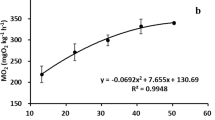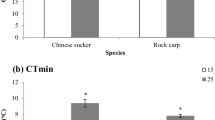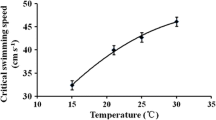Abstract
Brachymystax lenok tsinlingensis is an endangered teleost fish species that occurs in the Qinling Mountain region of China. It also happens to represent the southernmost distribution of an endemic Salmonid fish worldwide. Recently, the habitat of this species shifted towards a higher altitude presumably because of climate change, indicating that this species might be suffering from thermal stress. However, information on the thermal physiology of this species is extremely limited. Accordingly, we investigated the effects of acclimation temperature (6, 12, and 18 °C) on ecologically relevant end points such as critical thermal limits, swimming performance and metabolic rate. Our results showed that elevated acclimation temperatures resulted in increased thermal tolerance and decreased swimming efficiency. High temperature (i.e., 18 °C) did not have a marked effect on the critical swimming speed and the maximum metabolic rate but caused an increase in the energetic cost of transport compared with the results at 12 °C. Interestingly, we found that both the acclimation response ratio and the critical thermal maxima of B. lenok tsinlingensis were higher than that of many other Salmonidae fishes, suggesting that this species responds plastically to temperature changes and has a high thermal tolerance. These characteristics are hypothesized to be related to the southernmost distribution of this species.



Similar content being viewed by others
References
Angilletta MJ, Niewiarowski PH, Navas CA (2002) The evolution of thermal physiology in ectotherms. J Therm Biol 27:249–268
Bear EA, McMahon TE, Zale AV (2007) Comparative thermal requirements of westslope cutthroat trout and rainbow trout: implications for species interactions and development of thermal protection standards. Trans Am Fish Soc 136:1113–1121
Becker CD, Genoway RG (1979) Evaluation of the critical thermal maximum for determining thermal tolerance of freshwater fish. Environ Biol Fish 4:245–256
Beitinger TL, Bennett WA, McCauley RW (2000) Temperature tolerances of North American freshwater fishes exposed to dynamic changes in temperature. Environ Biol Fish 58:237–275
Bernatchez L, Dodson JJ (1985) Influence of temperature and current speed on the swimming capacity of lake whitefish (Coregonus clupeaformis) and cisco (C. artedii). Can J Fish Aquat Sci 42:1522–1529
Blake RW (2004) Fish functional design and swimming performance. J Fish Biol 65:1193–1222
Brahmane MP, Krishnani KK, Sarkar B, Sajjanar B, Kumar S, Nakhawa AD, Minhas PS (2014) Growth, thermal tolerance and oxygen consumption in rohu, Labeo rohita early fry acclimated to four temperatures. Afr J Agr Res 9:854–858
Brett JR (1964) The respiratory metabolism and swimming performance of young sockeye salmon. J Fish Res Board Can 21:1183–1226
Brett JR (1971) Energetic responses of salmon to temperature. A study of some thermal relations in the physiology and freshwater ecology of sockeye salmon, (Oncorhynchus nerkd). Am Zool 11:99–113
Casselman JM (2002) Effects of temperature, global extremes, and climate change on year-class production of warmwater, coolwater, and coldwater fishes in the Great Lakes Basin. In: McGinn NA (ed) Fisheries in a Changing Climate. American Fisheries Society, Bethesda, MD, pp 39–59
Chen Z, Snow M, Lawrence CS, Church AR, Narum SR, Devlin RH, Farrell AP (2015) Selection for upper thermal tolerance in rainbow trout (Oncorhynchus mykiss Walbaum). J Exp Biol 218:803–812
Chown SL, Hoffmann AA, Kristensen TN, Angilletta MJ Jr, Stenseth NC, Pertoldi C (2010) Adapting to climate change: a perspective from evolutionary physiology. Clim Res 43:3–15
Clark TD, Jeffries KM, Hinch SG, Farrell AP (2011) Exceptional aerobic scope and cardiovascular performance of pink salmon (Oncorhynchus gorbuscha) may underlie resilience in a warming climate. J Exp Biol 214:3074–3081
Claussen DL (1977) Thermal acclimation in ambystomatid salamanders. Comp Biochem Physiol A 58:333–340
Cooke SJ, Blumstein DT, Buchholz R, Caro T, Fernández-Juricic E, Franklin CE, Metcalfe J, O’Connor CM, Clair CC, Sutherland WJ, Wikelski M (2014) Physiology, behaviour and conservation. Physiol Biochem Zool 87:1–14
Dülger N, Kumlu M, Türkmen S, Ölçülü A, Eroldoğan OT, Yılmaz HA, Öçal N (2012) Thermal tolerance of European Sea Bass (Dicentrarchus labrax) juveniles acclimated to three temperature levels. J Therm Biol 37:79–82
Eliason EJ, Clark TD, Hague MJ, Hanson LM, Gallagher ZS, Jeffries KM, Gale MK, Patterson DA, Hinch SG, Farrell AP (2011) Differences in thermal tolerance among sockeye salmon populations. Science 332:109–112
Elliott JM, Davison W (1975) Energy equivalents of oxygen consumption in animal energetics. Oecologia 19:195–201
Elliott JM, Klemetsen A (2002) The upper critical thermal limits for alevins of Arctic charr from a Norwegian lake north of the Arctic circle. J Fish Biol 60:1338–1341
Farrell AP (2009) Environment, antecedents and climate change: lessons from the study of temperature physiology and river migration of salmonids. J Exp Biol 212:3771–3780
Ficke AD, Myrick CA, Hansen LJ (2007) Potential impacts of global climate change on freshwater fisheries. Rev Fish Biol Fisher 17:581–613
Fu SJ, Brauner CJ, Cao ZD, Richards JG, Peng JL, Dhillon R, Wang YX (2011) The effect of acclimation to hypoxia and sustained exercise on subsequent hypoxia tolerance and swimming performance in goldfish (Carassius auratus). J Exp Biol 214:2080–2088
Fu SJ, Peng ZG, Cao ZD, Peng JL, He XK, Xu D, Zhang AJ (2012) Habitat-specific locomotor variation among Chinese hook snout carp (Opsariichthys bidens) along a river. PLoS One 7:e40791. doi:10.1371/journal.pone.0040791
Fu C, Cao ZD, Fu SJ (2013) The effects of caudal fin loss and regeneration on the swimming performance of three cyprinid fish species with different swimming capacities. J Exp Biol 216:3164–3174
Guderley H, Blier P (1988) Thermal acclimation in fish-conservative and labile properties of swimming muscle. Can J Zool 66:1105–1115
Heath WG (1963) Thermoperiodism in sea-run cutthroat trout (Salmo clarki clarki). Science 142:486–488
Huey RB, Stevenson RD (1979) Integrating thermal physiology and ecology of ectotherms: a discussion of approaches. Am Zool 19:357–366
IPCC (2014) Climate change: synthesis report. Summary for policymakers
Jain KE, Farrell AP (2003) Influence of seasonal temperature on the repeat swimming performance of rainbow trout Oncorhynchus mykiss. J Exp Biol 206:3569–3579
Kelley AL (2014) The role thermal physiology plays in species invasion. Conserv Physiol 2:cou045. doi:10.1093/conphys/cou045
Kelly NI, Burness G, McDermid JL, Wilson CC (2014) Ice age fish in a warming world: minimal variation in thermal acclimation capacity among lake trout (Salvelinus namaycush) populations. Conserv Physiol 2:cou025. doi:10.1093/conphys/cou025
Killen SS, Atkinson D, Glazier DS (2010) The intraspecific scaling of metabolic rate with body mass in fishes depends on lifestyle and temperature. Ecol Lett 13:184–193
Lee RM, Rinne JN (1980) Critical thermal maxima of five trout species in the southwestern United States. Trans Am Fish Soc 109:632–635
Lee CG, Farrell AP, Lotto A, Hinch SG, Healey MC (2003) Excess post-exercise oxygen consumption in adult sockeye (Oncorhynchus nerka) and coho (O. kisutch) salmon following critical speed swimming. J Exp Biol 206:3253–3260
Li XC, Wang LZ (2005) Effect of thermal acclimation on preferred temperature, avoidance temperature and lethal thermal maximum of Macrobiotus harmsworthi Murray (Tardigrada, Macrobiotidae). J Therm Biol 30:443–448
Li XM, Cao ZD, Fu SJ (2010) The effect of exercise training on the metabolic interaction between feeding and locomotion in the juvenile southern catfish (Silurus meridionalis Chen). J Exp Zool A 313:557–563
Liu H, Li Y, Liu X, Zou G, Wei Q (2013) Isolation and characterization of eleven novel microsatellite loci of Brachymystax lenok tsinlingensis, a threatened fish endemic to Shaanxi, China. Conserv Genet Resour 5:389–391
Lohr SC, Byorth PA, Kaya CM, Dwyer WP (1996) High-temperature tolerances of fluvial Arctic grayling and comparisons with summer river temperatures of the Big Hole River, Montana. Trans Am Fish Soc 125:933–939
MacNutt MJ, Hinch SG, Farrell AP, Topp S (2004) The effect of temperature and acclimation period on repeat swimming performance in cutthroat trout. J Fish Biol 65:342–353
McCullough DA, Bartholow JM, Jager HI, Beschta RL, Cheslak EF, Deas ML, Ebersole JL, Foott JS, Johnson SL, Marine KR, Mesa MG, Petersen JH, Souchon Y, Tiffan KF, Wurtsbaugh WA (2009) Research in thermal biology: burning questions for coldwater stream fishes. Rev Fish Sci 17:90–115
Myrick CA, Cech JJ Jr (2005) Effects of temperature on the growth, food consumption, and thermal tolerance of age-0 Nimbus-strain steelhead. N Am J Aquacult 67:324–330
Norin T, Clark TD (2016) Measurement and relevance of maximum metabolic rate in fishes. J Fish Biol 88:122–151
Norin T, Malte H, Clark TD (2014) Aerobic scope does not predict the performance of a tropical eurythermal fish at elevated temperatures. J Exp Biol 217:244–251
Ohlberger J, Mehner T, Staaks G, Hölker F (2008) Temperature-related physiological adaptations promote ecological divergence in a sympatric species pair of temperate freshwater fish, Coregonus spp. Funct Ecol 22:501–508
Pang X, Yuan XZ, Cao ZD, Fu SJ (2013) The effects of temperature and exercise training on swimming performance in juvenile qingbo (Spinibarbus sinensis). J Comp Physiol B 183:99–108
Peng J, Cao ZD, Fu SJ (2014) The effects of constant and diel-fluctuating temperature acclimation on the thermal tolerance, swimming capacity, specific dynamic action and growth performance of juvenile Chinese bream. Comp Biochem Physiol A 176:32–40
Plaut I (2001) Critical swimming speed: its ecological relevance. Comp Biochem Physiol A 131:41–50
Re AD, Diaz F, Sierra E, Rodriguez J, Perez E (2005) Effect of salinity and temperature on thermal tolerance of brown shrimp Farfantepenaeus aztecus (Ives) (Crustacea, Penaeidae). J Therm Biol 30:618–622
Ren J, Liang G (2004) Resource survey report of Brachymystax lenok tsinlingensis in Qianhe River Valleys of Qinling Mountains. J Shaanxi Norm Univ 32:165–168
Roche DG, Binning SA, Bosiger Y, Johansen JL, Rummer JL (2013) Finding the best estimates of metabolic rates in a coral reef fish. J Exp Biol 216:2103–2110
Sears MW, Raskin E, Angilletta MJ (2011) The world is not flat: defining relevant thermal landscapes in the context of climate change. Integr Comp Biol 51:666–675
Selong JH, McMahon TE, Zale AV, Barrows FT (2001) Effect of temperature on growth and survival of bull trout, with application of an improved method for determining thermal tolerance in fishes. Trans Am Fish Soc 130:1026–1037
Tu Z, Yuan X, Han J, Shi X, Huang Y, Johnson D (2011) Aerobic swimming performance of juvenile Schizothorax chongi (Pisces, Cyprinidae) in the Yalong River, southwestern China. Hydrobiologia 675:119–127
Tucker VA (1970) Energetic cost of locomotion in animals. Comp Biochem Physiol 34:841–846
Underwood ZE, Myrick CA, Rogers KB (2012) Effect of acclimation temperature on the upper thermal tolerance of Colorado River cutthroat trout Oncorhynchus clarkii pleuriticus: thermal limits of a North American salmonid. J Fish Biol 80:2420–2433
Whitney JE, Al-Chokhachy R, Bunnell DB, Caldwell CA, Cooke SJ, Eliason EJ, Rogers M, Lynch AJ, Paukert CP (2016) Physiological basis of climate change impacts on North American inland fishes. Fisheries 41:332–345
Willi Y, Van Buskirk J, Hoffmann AA (2006) Limits to the adaptive potential of small populations. Annu Rev Ecol Evol Syst 37:433–458
Xia JG, Nie LJ, Mi XM, Wang WZ, Ma YJ, Cao ZD, Fu SJ (2015) Behavior, metabolism and swimming physiology in juvenile Spinibarbus sinensis exposed to PFOS under different temperatures. Fish Physiol Biochem 41:1293–1304
Yan GJ, He XK, Cao ZD, Fu SJ (2013) An interspecific comparison between morphology and swimming performance in cyprinids. J Evol Biol 26:1802–1815
Zeng LQ, Cao ZD, Fu SJ, Peng JL, Wang YX (2009) Effect of temperature on swimming performance in juvenile southern catfish (Silurus meridionalis). Comp Biochem Physiol A 153:125–130
Zhao Y, Zhang C (2009) Threatened fishes of the world: Brachymystax lenok tsinlingensis Li, 1966 (Salmonidae). Environ Biol Fish 86:11–12
Zheng XL, Bu SH, Dai SF, Li XM, Zhang H, Li AJ (2010) Ecological adaptations of Brachymystax lenok to the south Taibai mountain. J Northwest AF Univ 38:52–58
Acknowledgements
This study was funded by the National Natural Science Foundation of China (31300340) and the Youth Top-notch Talent Cultivation Program of Chongqing Normal University (14CSBJ08). We are grateful to Prof. G. Liang from Shaanxi Normal University, China, for helping us collect the fish.
Author information
Authors and Affiliations
Corresponding author
About this article
Cite this article
Xia, J., Ma, Y., Fu, C. et al. Effects of temperature acclimation on the critical thermal limits and swimming performance of Brachymystax lenok tsinlingensis: a threatened fish in Qinling Mountain region of China. Ecol Res 32, 61–70 (2017). https://doi.org/10.1007/s11284-016-1418-z
Received:
Accepted:
Published:
Issue Date:
DOI: https://doi.org/10.1007/s11284-016-1418-z




